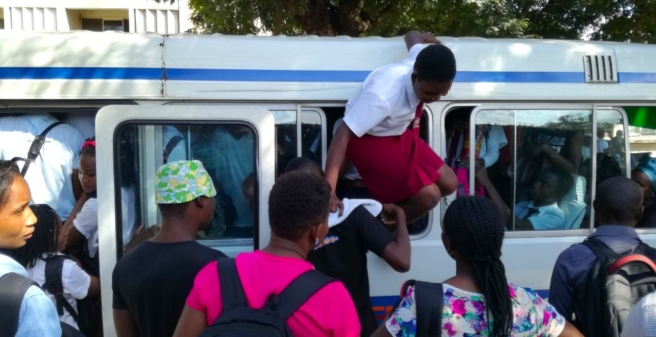
“Fear has its uses, but cowardice has none”
Anne McCaffrey
In recent decades, social development has significantly changed living conditions in rural and urban areas. Half of the world’s population lives in urban areas, resulting in centres of high population density that cause a large dispersion to more distant areas, called metropolitan regions. This population growth creates a geographical segregation, generating large-scale settlements fragmented by lack of transport. This leads to unequal urban development, where people from the same community have better access to health, work and education than others. This problem becomes more relevant if we consider that the majority of Mozambicans work in subsistence agriculture, which denotes a strong rupture of attributions, regarding the right to accessibility and inclusion in health and education centres. [i] [ii]
In terms of mobility, people living in the most disadvantaged areas of cities are disadvantaged in commuting to work, due to the limited supply of public transport. For example, the average commuting time in Nairobi, Kenya, is one of the longest in developing cities [iii]. In Kampala, Uganda, 80% of people walk to work as they cannot afford transport [iv]. As a consequence of this situation of reduced mobility, we must recognise that mobility is an individual right and a fundamental factor for the social integration of citizens, without which a large proportion would be excluded [v]. The use of private vehicles is still popular and helps to offset the problems caused by social fragmentation, however, it also has negative effects, especially on the environment. As a whole, these factors lead to a society polarisation between those who have access to a car and those who do not.
The Maputo Metropolitan Area (MMA) represents about 8.5% of the country’s total population and accounts for 17% of its GDP. In this area, public transport is inaccessible to many people due to its remote location, poor road network and highly irregular transport services. Accessibility to jobs, health services and education for the MMA’s most vulnerable population is one of the lowest in Africa, which contributes to social exclusion and slows down the region’s human capital development. Public transport in Maputo City represents only 9.2% of the means of transport used in the city, while informal public transport accounts for 32.9%, travel on foot 45.9%, private cars 10.2%, motorbikes 0.2% and cargo vehicles 0.7%[vi], [vii].
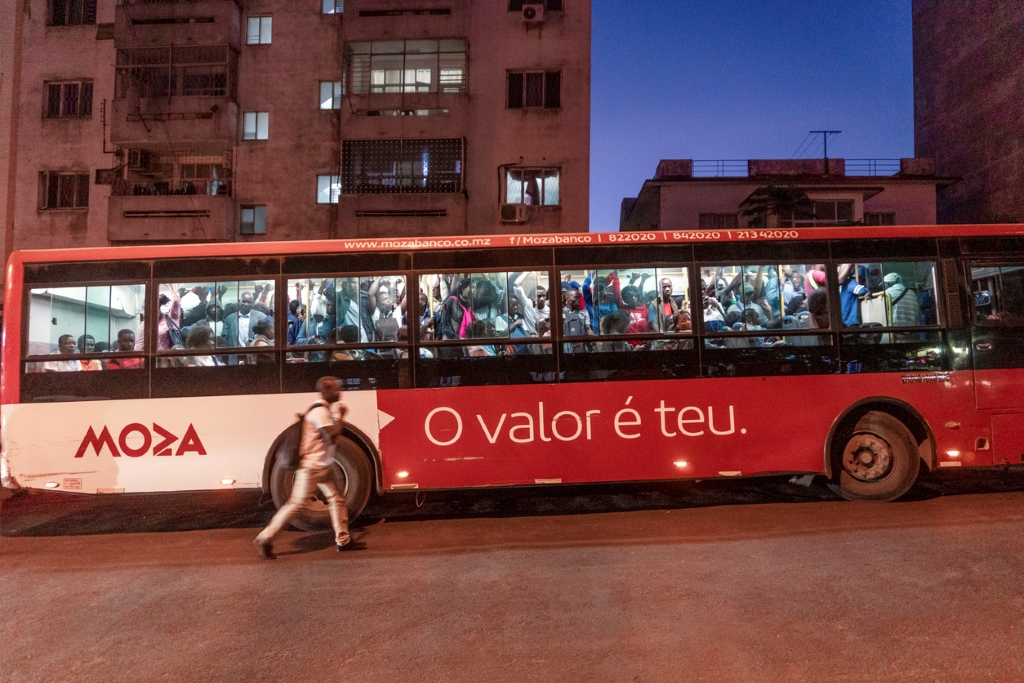
Navigating the Maze
Maputo’s rapid urbanisation has driven residential and industrial growth in areas such as Matola and Marracuene. Despite the low density, a major challenge is to connect sparsely populated areas growing on the periphery and facing high poverty rates. The supply of public transport is insufficient to meet the growing demand, resulting in overcrowding of vehicles, long waiting times and the use of illegal transport methods such as the pick-up trucks known as “My Love”.
As a response to the lack of mobility, minibuses, called “chapas”, have emerged as the main means of informal public transport. While the chapas have played an important role in people’s mobility, they also entail negative impacts such as air pollution, greenhouse gas emissions and traffic accidents. The chapas’ drivers often avoid the poorest and most difficult to access neighbourhoods, leaving many people without public transport. Recent studies show that low-income people walk more and use more informal transport.
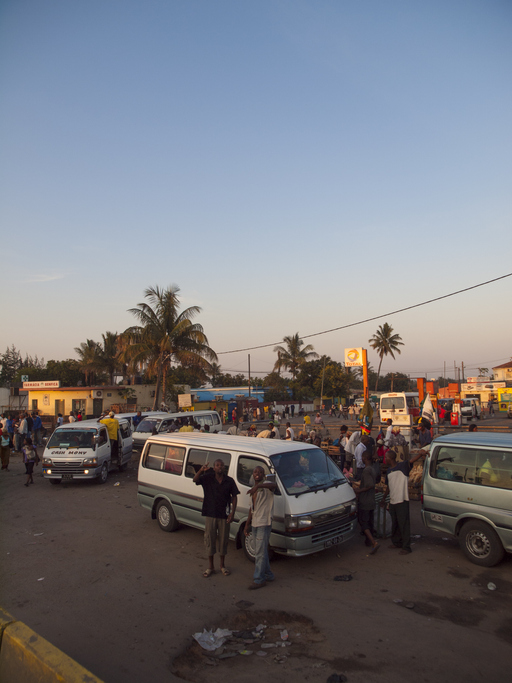
Gender inequality is a major challenge in the sector. Women tend to make more trips related to child and family care, while work and business trips represent over 50% of all trips for men. Personal safety is a major concern for women, something that impacts the choice of means of transport, times, and often deters from making the trips[viii] [ix].
Road safety is also a critical issue, with the number of traffic accidents increasing in the last decade. It is estimated that between 7,000 and 10,000 people die on Mozambique’s roads each year, which represents about 10% of the annual GDP [x].
Another major challenge is the lack of capacity of government agencies in the sector in terms of staff, specialist skills and experience in planning, regulation, management and financing of urban transport. While the creation of the Metropolitan Transport Authority (MTA) was an important step in addressing institutional coordination, it is still substantially underfunded to fulfil its mission.
The transport system in Mozambique is vulnerable to climate change and natural disasters harming mainly the clandestine constructions. A recent survey in MMA[xi] found that flooding affected the travel of 36% of respondents during the rainy season, with impacts ranging from changing routes (15%) to preventing people from reaching their destination (3%). Furthermore, it is anticipated that Maputo and Matola will continue their urban growth with an increase in settlements in vulnerable areas, which will only exacerbate the risk and impacts of flooding events on the streets and affecting transport services [xii].
People with disabilities in Mozambique represent 2.6% of the country’s population, with 21% being children between the ages of 0 and 15. The country has specific provisions[xiii] in transport regulations for disabled people, such as the presence of discounts and payment exemptions on public transport and accessibility regulations [xiv] to build accessible infrastructure. However, efforts are limited, and factors such as quality of service, design considerations and enforcement are key to an inclusive public transport system.
A Move in the Right Direction: How Maputo’s Transportation Landscape is Evolving
The idea of a new paradigm started in 2019, four years before the launch of the MOVE project, when the coordination and implementation of mobility policies in the Maputo Metropolitan Area began. In this sense, training courses were promoted for government officials, with the aim of raising awareness of technicians and political decision-makers, about the new mobility models. Maputo’s citizens were also called to participate in an event that symbolised a shift towards more sustainable transport, such as the first bicycle route in the city[xv], which brought together more than a hundred people. Although this situation may seem common in cities like Copenhagen, in Maputo it is a rarity, since this form of transport is not widely used, especially in a city that does not have bicycle lanes.
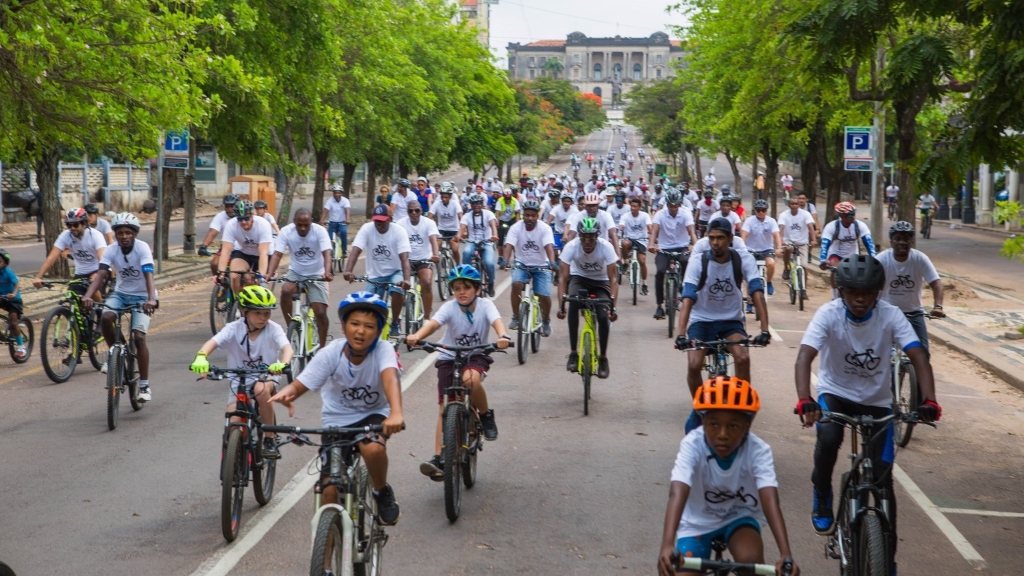
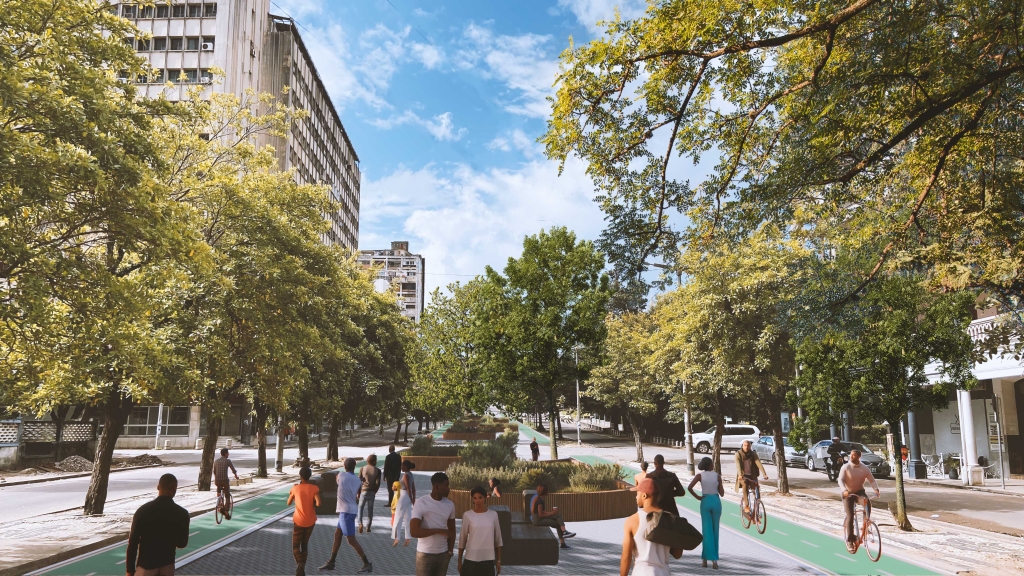
But the event that marked a before and after was the decision to build the first bus rapid transit (BRT) system. Currently, BRT systems exist in cities such as Dar es Salaam, Lagos, Cape Town, Johannesburg and Pretoria in South Africa. Furthermore, there are also 12 projects in the preparation/construction phase across Africa, including Abidjan, Dakar, Douala, Kampala, Kumasi and Ouagadougou, with technical and financial assistance from the World Bank[xvi]. The BRT, designed as a passenger transport system that circulates in exclusive lanes, offers, unlike the conventional bus, greater capacity, speed and efficiency in its maintenance and greater safety for passengers. Since it does not share the traffic lane with other vehicles, the BRT reduces congestion, avoids delays and makes the journey more predictable. On the other hand, the BRT also has a lower environmental impact, reducing emissions of greenhouse gases and smoke[xvii].
In August 2022, the World Bank approved a US$ 250 million grant for the Urban Mobility project in Maputo [xviii]. In this line of action, the Mozambican Ministry of Transport and Communications launched the “MOVE MAPUTO” program, under the slogan “We make the far become near, transporting people and shortening distances”. [xix]. Although it resembles only an infrastructure project, MOVE is much more than that. The project aims to improve services to users, strengthen the institutions responsible for urban transport, improve the regulatory and legislative framework, support the professionalisation of operators, finance the empowerment of public sector employees and provide training for young professionals in different disciplines to enable them to become the future leaders of urban mobility.
MOVE includes plans for a 19-km segregated BRT line[xx] connecting downtown Maputo to Praça da Juventude in Magoanine and Rotunda Missão Roque in Zimpeto. The BRT service will also offer direct routes connecting to other major terminals in Maputo, Matola and Marracuene, covering a total of 46 km of non-segregated BRT services. The BRT will provide direct and quality services to approximately 124,000 passengers per day. The neighbourhoods served will have access to safer and more resilient roads, with renewed lighting and pavements, pedestrian routes, cycling lanes, paved roads and water drainage systems. In addition to the infrastructure, the project foresees the possibility of acquiring 120 buses, which will make approximately 1,150 daily trips, which will allow for an additional supply of around 40 million trips per year.
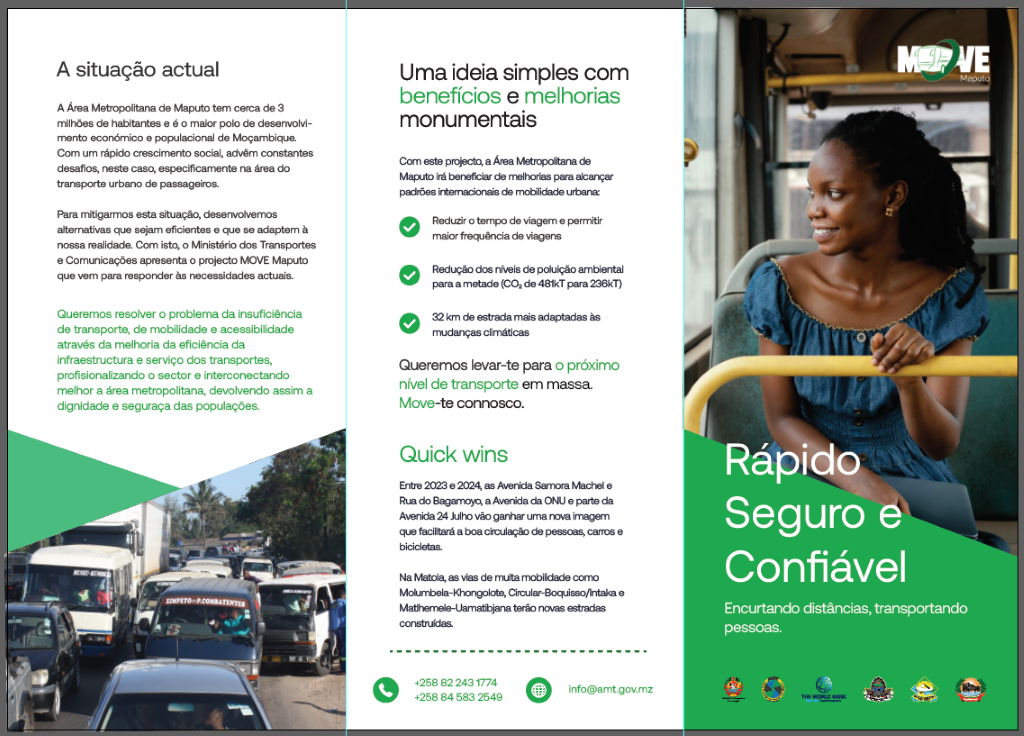
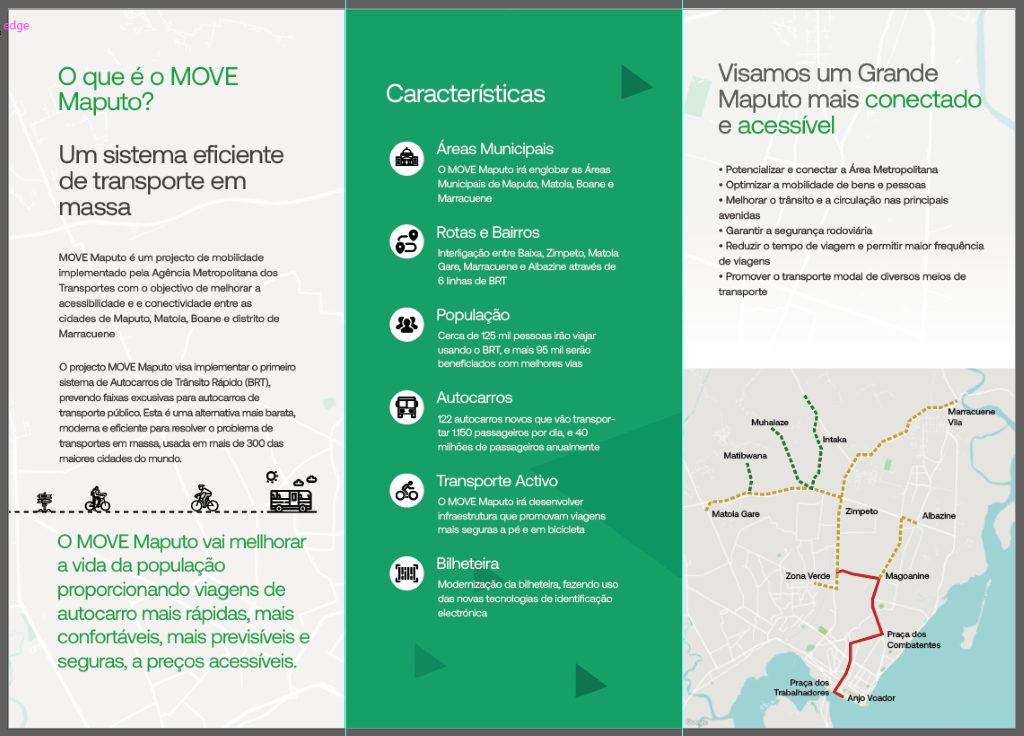
Thus, the BRT will bring significant benefits for accessibility, including travel time reduction by approximately 22%, traffic decongestion, road safety and reduced environmental pollution. The project promotes more efficient and sustainable urban mobility, helping to make the city of Maputo a more pleasant and liveable place for everyone.
The announcement by Mozambique’s Minister of Transport and Communications on the adoption of electric vehicles for BRT represents a major opportunity for Mozambique. The country heavily subsidises fossil fuels, accounting for almost 9% of the GDP, while subsidies to public transport are only 0.05% of the GDP[xxi]. Currently, a bus consumes on average 90-110 litres of fuel per day and travels about 200 km, while a “chapa” (popular means of transport) uses about 20% more fuel, and emits 50% more CO2 per kilometre, carrying fewer passengers.[xxii]
These factors negatively affect labour productivity, respiratory health and reduce the effective time of day. In addition, reliance on fossil fuels makes the cost of transport more sensitive to price increases, which can result in higher fares and impact low-income groups, especially in urban areas[xxiii].
Electrifying the BRT will be an opportunity to reduce CO2 emissions, improve air quality, reduce dependence on fossil fuels and reduce transport costs. Furthermore, it can create opportunities for the local economy, especially if the electric vehicles are produced and maintained locally.
A New Road Ahead: Redefining Mobility for the Future
Being part of this cultural change is a very rewarding experience. Well targeted, the current innovations in urban mobility can help improve the lives of Mozambicans. For sustainable transport policies to succeed, it is important to strengthen institutions.
It is also crucial to improve the capacity of municipalities to implement urban transport projects and to better coordinate at metropolitan level. Let us take this opportunity to empower and train operators, improve the efficiency and performance of services, AND train young professionals to become the next leaders in mobility.
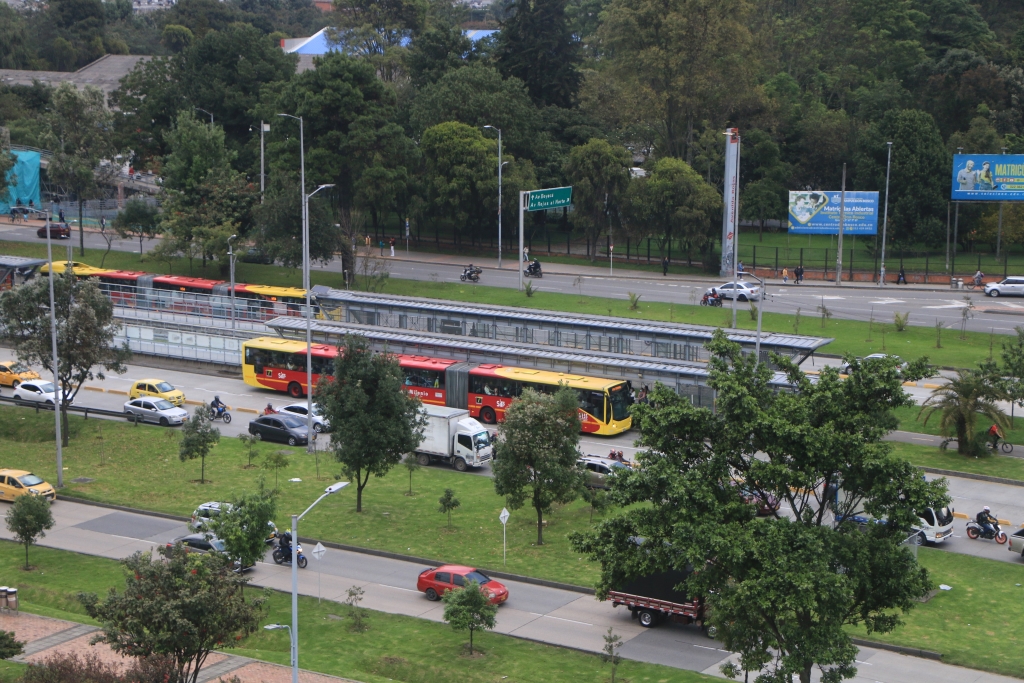
We should not expect the BRT to bring the solution to all mobility problems. It is necessary to approach the transport system in a holistic and integrated way. The TransMilenio BRT in Bogotá[xxiv], was a milestone in the history of public transport and an example to the world. However, in recent years, TransMilenio is not as popular as it used to be, mostly due to overcrowding and long queues at stations, caused by the rapid growth of the city, lack of planning and integration with other means of transport. In contrast, the city of Buenos Aires shows the opposite; a sustainable urban mobility plan that is constantly growing and expanding. New corridors are being built, metro stations are being extended, more kilometres of bicycle lanes are being created and public space is being revitalised.
Something that must be carefully studied is the fare structure and planning of the BRT system. The current level of fares is not sufficient to achieve financial viability without subsidies and concessional financial support. If fares are too high, it may result in economic unsustainability of the BRT, which would lead to a reduction in service quality and consequently discourage people to use it. The low level of regulated fares is one of the main issues raised by operators in relation to the lack of ability to pay for vehicle financing. This implies that if the tariffs are too low, it may create challenges for operators to finance their operations and invest in improving their services. Therefore, there needs to be a balance between affordability for users and financial viability for operators to ensure the sustainability of the BRT system.
The MOVE project offers an opportunity for governments to work together, restructure their budgets, prioritising the most profitable initiatives, as well as proclaiming the fight against climate change. The government must seize the opportunity to make transport systems more resilient and be prepared for natural disasters. Greater public investment is needed in preventing damage (adaptation measures), rather than investing only in relief and recovery (mitigation). The challenges to meeting national climate change targets through infrastructure investment will not just be in engineering or technology, but more related to government and public policy[xxv].
BRT presents great freedom for innovation and implementation of sustainable technologies. Some examples of the innovation in BRT include: electric vehicles (i.e. Guangzhou), solar panels (Curitiba), LED lighting (Bogotá), sustainable stations that may include the use of recycled materials, rainwater harvesting systems, and natural ventilation systems (Ahmedabad). Therefore, it is crucial that climate adaptation measures are considered from the initial planning of the system to ensure its resilience and long-term sustainability.
The MOVE project is undoubtedly an achievement that reveals a new paradigm in terms of mobility, accessibility and inclusion, and not only for the middle and lower classes of Mozambican society, but also for the benefit of children, the elderly and people with reduced capacities. In other words, it is a success towards a more inclusive society.
Lucila Spotorno is Senior Transport Advisor at the Tony Blair Institute, Maputo/Mozambique


[i] Nações Unidas. Objetivo 11: Lograr que las ciudades sean más inclusivas, seguras, resilientes y sostenibles. [Online]. Available at: https://www.un.org/sustainabledevelopment/es/cities/. Visited at 03.05.2023
[ii] World Bank. Urban Development. [Online]. Available at: https://www.worldbank.org/en/topic/urbandevelopment/overview. Visited at 04.05.2023
[iii] Lall, Somik Vinay; Henderson, J. Vernon; Venables, Anthony J.. Africa’s Cities: Opening Doors to the World. Washington, DC: World Bank. 2017
[iv] MEIR Engineering & Research Ltd, GIZ. Dr Andrew Bwambale, Dr Luanne Stevens, Ms Grace Mukunzi. Collection for Climate Change Mitigation Potential Analysis and Scenario Development in Uganda’s Transport Sector. Final Data Compilation Report Data. 2021
[v] Rosario Macario. Managing Urban Mobility Systems. Esmerald Group Limited. 2011
[vi] Mobilize Your City. Global Monitor, Factsheet: Maputo, Mozambique. 2021.
[vii] The World Bank. Maputo Metropolitan Area Urban Mobility Project. [Online]. Available at: https://projects.worldbank.org/en/projects-operations/project-detail/P175322. Visited at 04.04.2023
[viii] Challenges from the Final Report Pre-feasibility study, ITP for World Bank. 2020
[ix] The World Bank. Maputo Metropolitan Area Urban Mobility Project. [Online]. Available at: https://projects.worldbank.org/en/projects-operations/project-detail/P175322. Visited at 03.04.2023
[x] World Bank 2017 mentioned in Maputo Metropolitan Area Urban Mobility Project PAD. [Online]. Available at: https://projects.worldbank.org/en/projects-operations/project-detail/P175322
[xi] Fatima Arroyo Arroyo. Connecting the Dots in the Maputo Metropolitan Area: Diagnostic of urban mobility and accessibility. The World Bank. 2021.
[xii] The World Bank. Mozambique Urbanization Review. The World Bank. 2018
[xiii] Decree Law No. 11/2009, Mozambique
[xiv] Decree Law No. 53/2008, Mozambique
[xv] Amandio Borges. Necessárias ciclovias em Maputo para uso da bicicleta como meio de transporte seguro. [Online]. Available at: https://opais.co.mz/necessarias-ciclovias-em-maputo-para-uso-da-bicicleta-como-meio-de-transporte-seguro/. 2022. Visited at 01.03.2023
[xvi] Global BRT DATA. Available at: https://brtdata.org/location/africa. Visited at 01.03.2023
[xvii] Joel Mokyr A Cultural of Growth: The origins of the Modern Economy (Graz Schumpeter Lecture), 2 Publisher: Princeton University Press. 2016
[xviii] The World Bank. Banco Mundial apoia transportes urbanos na Área Metropolitana de Maputo. [Online]. Available at: https://www.worldbank.org/pt/news/press-release/2022/08/24/world-bank-supports-urban-transport-in-the-maputo-metropolitan-area. 2022. Visited at 01.03.2023
[xix] Rádio Moçambique. Cidades de Maputo, Matola e Boane terão BRT a partir de 2027. Available at: https://www.rm.co.mz/cidades-de-maputo-matola-e-boane-terao-brt-a-partir-de-2027/. Visited at 01.03.2023
[xx] Final Report Pre-feasibility study, ITP for World Bank. 2020
[xxi] International Monetary Fund. Fiscal Affairs Dept. Republic of Mozambique: Technical Assistance Report on Fuel Subsidy and Pricing Reform. IMF Staff Country Reports 2023.017. 2015.
[xxii] Study of Urban Transport in Metropolitan Maputo. Final Report Version. Produced by ITP For the World Bank. 2021
[xxiii] Study of Urban Transport in Metropolitan Maputo. Final Report Version. Produced by ITP For the World Bank. 2021
[xxiv] Alix Hoechster. Moving Bogota. Passengers perceptions of El Sistema TransMilenio. City University of New York School of Professionals Studies. 2015. Available at: Microsoft Word – The Sistema TransMilenio of Bogotá.docx (cuny.edu)
[xxv] José A. Gómez-Ibáñez, Zhi Liu. Infrastructure Economics and Policy International Perspectives. Lincoln Institute of Land Policy. 2021.
Literatur:
- Nações Unidas. Objetivo 11: Lograr que las ciudades sean más inclusivas, seguras, resilientes y sostenibles. [Online]. Available at: https://www.un.org/sustainabledevelopment/es/cities/. Visited at 03.05.2023
- World Bank. Urban Development. [Online]. Available at: https://www.worldbank.org/en/topic/urbandevelopment/overview. Visited at 04.05.2023
- Lall, Somik Vinay; Henderson, J. Vernon; Venables, Anthony J.. Africa’s Cities: Opening Doors to the World. Washington, DC: World Bank. 2017
- MEIR Engineering & Research Ltd, GIZ. Dr Andrew Bwambale, Dr Luanne Stevens, Ms Grace Mukunzi. Collection for Climate Change Mitigation Potential Analysis and Scenario Development in Uganda’s Transport Sector. Final Data Compilation Report Data. 2021
- Rosario Macario. Managing Urban Mobility Systems. Esmerald Group Limited. 2011
- Mobilize Your City. Global Monitor, Factsheet: Maputo, Mozambique. 2021.
- The World Bank. Maputo Metropolitan Area Urban Mobility Project. [Online]. Available at: https://projects.worldbank.org/en/projects-operations/project-detail/P175322. Visited at 04.04.2023
- Challenges from the Final Report Pre-feasibility study, ITP for World Bank. 2020
- The World Bank. Maputo Metropolitan Area Urban Mobility Project. [Online]. Available at: https://projects.worldbank.org/en/projects-operations/project-detail/P175322. Visited at 03.04.2023
- World Bank 2017 mentioned in Maputo Metropolitan Area Urban Mobility Project PAD. [Online]. Available at: https://projects.worldbank.org/en/projects-operations/project-detail/P175322
- Fatima Arroyo Arroyo. Connecting the Dots in the Maputo Metropolitan Area: Diagnostic of urban mobility and accessibility. The World Bank. 2021.
- The World Bank. Mozambique Urbanization Review. The World Bank. 2018
- Decree Law No. 11/2009, Mozambique
- Decree Law No. 53/2008, Mozambique
- Amandio Borges. Necessárias ciclovias em Maputo para uso da bicicleta como meio de transporte seguro. [Online]. Available at: https://opais.co.mz/necessarias-ciclovias-em-maputo-para-uso-da-bicicleta-como-meio-de-transporte-seguro/. 2022. Visited at 01.03.2023
- Global BRT DATA. Available at: https://brtdata.org/location/africa. Visited at 01.03.2023
- Joel Mokyr A Cultural of Growth: The origins of the Modern Economy (Graz Schumpeter Lecture), 2 Publisher: Princeton University Press. 2016
- The World Bank. Banco Mundial apoia transportes urbanos na Área Metropolitana de Maputo. [Online]. Available at: https://www.worldbank.org/pt/news/press-release/2022/08/24/world-bank-supports-urban-transport-in-the-maputo-metropolitan-area. 2022. Visited at 01.03.2023
- Rádio Moçambique. Cidades de Maputo, Matola e Boane terão BRT a partir de 2027. Available at: https://www.rm.co.mz/cidades-de-maputo-matola-e-boane-terao-brt-a-partir-de-2027/. Visited at 01.03.2023
- Final Report Pre-feasibility study, ITP for World Bank. 2020
- International Monetary Fund. Fiscal Affairs Dept. Republic of Mozambique: Technical Assistance Report on Fuel Subsidy and Pricing Reform. IMF Staff Country Reports 2023.017. 2015.
- Study of Urban Transport in Metropolitan Maputo. Final Report Version. Produced by ITP For the World Bank. 2021
- Study of Urban Transport in Metropolitan Maputo. Final Report Version. Produced by ITP For the World Bank. 2021
- Alix Hoechster. Moving Bogota. Passengers perceptions of El Sistema TransMilenio. City University of New York School of Professionals Studies. 2015. Available at: Microsoft Word – The Sistema TransMilenio of Bogotá.docx (cuny.edu)
- José A. Gómez-Ibáñez, Zhi Liu. Infrastructure Economics and Policy International Perspectives. Lincoln Institute of Land Policy. 2021

